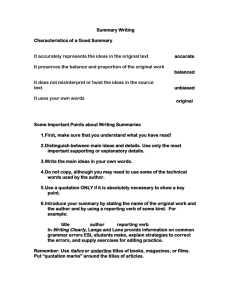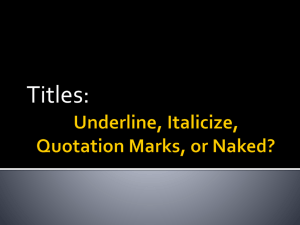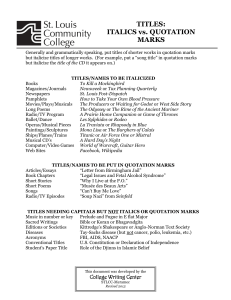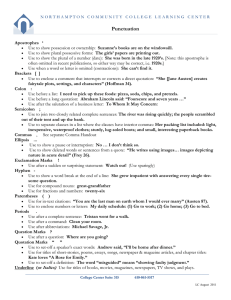Rules for the Preparation of Typed and Printed Texts
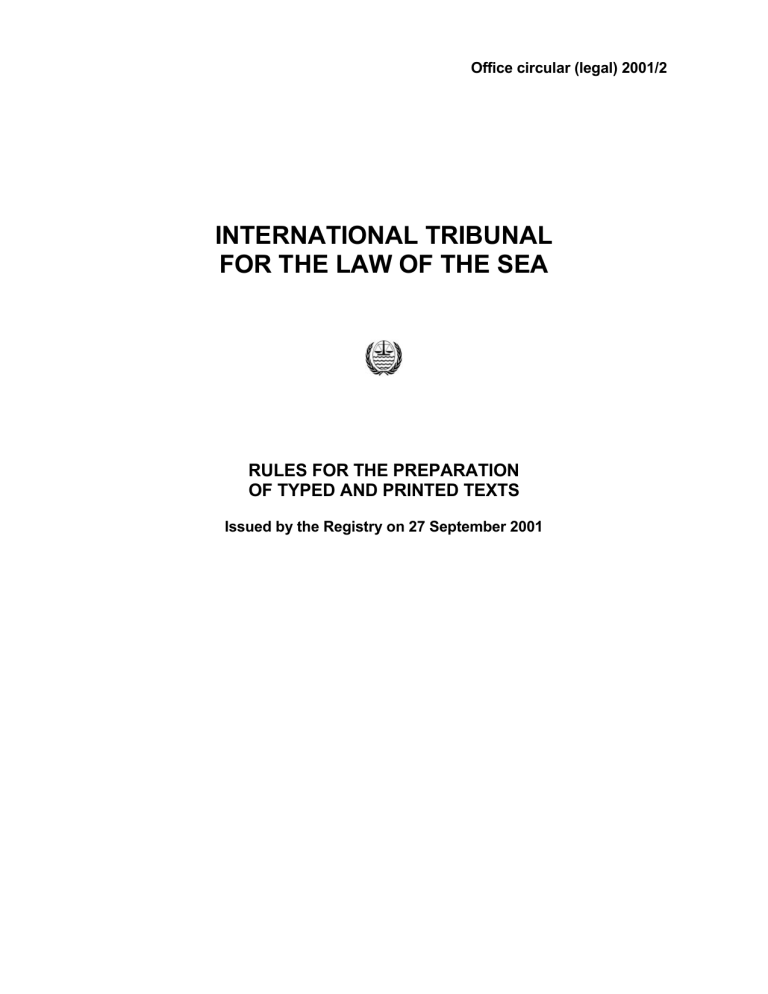
Office circular (legal) 2001/2
INTERNATIONAL TRIBUNAL
FOR THE LAW OF THE SEA
RULES FOR THE PREPARATION
OF TYPED AND PRINTED TEXTS
Issued by the Registry on 27 September 2001
i
Paragraph 1 of the Guidelines concerning the Preparation and Presentation of
Cases before the Tribunal issued by the Tribunal on 28 October 1997 requires the parties to consult the Registry’s Rules for the Preparation of Typed and Printed
Texts . These Rules are attached.
ii
A.
B.
G.
H.
I.
C.
D.
E.
F.
Table of Contents
Layout of Pleadings .....................................................................................
1.
2.
3.
4.
5.
Page set-up.......................................................................................
Title page ..........................................................................................
First page of the pleading proper ......................................................
First page of the annexes..................................................................
Text of the annexes...........................................................................
Part Titles, Chapter Titles and Subtitles.......................................................
1.
2.
3.
4.
5.
6.
Part titles ...........................................................................................
Chapter titles .....................................................................................
Subtitles ............................................................................................
Titles of the annexes .........................................................................
Titles of appendices and sub-annexes..............................................
Punctuation .......................................................................................
Subdivided Paragraphs................................................................................
Quotations ...................................................................................................
Notes .........................................................................................................
References ..................................................................................................
Italics ..........................................................................................................
Abbreviations and Acronyms .......................................................................
Numbers and Dates .....................................................................................
1
A.
Layout of Pleadings
1. Page set-up
1.
Every pleading and its supporting documents should be printed, typewritten or prepared electronically in a version of Word for Windows. Printed or typed text should be of a quality sufficient to be processed by optical character recognition
(OCR). The desired paper size is A4 (21 x 29.7 cm, 8.27" x 11.69"). The line spacing should be single. The preferred fonts are Times New Roman and Arial. The size should be 12 pt. for the text including all quotations, 10 pt. for the footnotes, page numbers and the running heads.
2.
The following settings should be used for margins:
Top:
Bottom:
Left:
Right:
Header:
Footer:
2.54 cm
3 cm
2.54 cm
2.54 cm
1.25 cm
2.54 cm
1 inch
1.18 inches
1 inch
1 inch
0.49 inches
1 inch
3.
The text should be aligned on the left side.
2. Title page
The top line should be in 14 pt. capitals, centred, as follows:
INTERNATIONAL TRIBUNAL FOR THE LAW OF THE SEA
4.
The title of the case 1 should be in 14 pt. and the names of the parties in 12 pt.; they should be in bold, capitals and centred, as follows, when the proceedings are instituted by means of an application:
[NAME OF CASE]
[NAME OF APPLICANT] v.
[NAME OF RESPONDENT]
Or, when the proceedings are brought by the notification of a special agreement:
[NAME OF CASE]
[NAME OF PARTY A] / [NAME OF PARTY B]
5.
The title of the pleading should be in 14 pt. capitals, centred, as follows:
[NAME OF PLEADING] OF [NAME OF PARTY]
1
If already known at the time of submission of the pleading.
2
6.
The date of the pleading should be in 14 pt. capitals, centred, as follows:
3.
[DD MONTH YYYY]
First page of the pleading proper
7.
The title of the pleading should be at the head of the page in 12 pt. capitals, bold, centred, e.g. as follows:
8.
COUNTER-MEMORIAL OF [NAME OF PARTY]
4.
First page of the annexes
The general title should be in pt. 12, bold, centred, as follows:
Annexes to the [name of pleading] of [name of party]
5.
Text of the annexes
9.
Every annex should be given a header in 10 pt., which must be repeated at the top of each page of the annex. However, photocopied documents reproduced in the annexes do not need to have a running head.
10.
Photocopied documents reproduced in the annexes must be legible. If a document either in whole or in part is in fine print, it should be enlarged to 12 pt.
Oversize documents (e.g., large maps) may be properly folded.
B. Part Titles, Chapter Titles and Subtitles
11.
A title of a part must be printed on a right-hand page and be followed by a blank page. The part number should be in capital Roman numerals, e.g
., as follows:
2.
PART I
PART II
Chapter titles
12.
A chapter title should be in bold capitals, starting on a new page. The chapter number should be in Arabic numerals, e.g., as follows:
CHAPTER 1
13.
The wording of the chapter title is underneath, in bold capitals, centred, e.g., as follows:
STATEMENT OF FACTS
3
3.
Subtitles
14.
The order in which subtitles succeed each other and the layout of subtitles should be as follows:
(a) The first subtitle should be in bold, centred and preceded by a Roman numeral and a full stop, e.g., as follows:
I. Jurisdiction
Subtitles should be centred. If the subtitle consists of more than one line, it is to be set to the width of the printed page and the last line is centered, as follows:
I. Xxxxxxxxxxxxxxxxxxxxxxxxxxxxxxxxxxxxxxxxxxxxxxxxxxxxxxxxxxxxxxx xxxxxxxxxxxx
(b) The second subtitle should be centred, preceded by a capital letter and a full stop, e.g., as follows:
A. Objections to jurisdiction
If the subtitle is more than one line in length, the same rule as under (a) applies.
(c) The third subtitle should be in italics and centred, preceded by an Arabic numeral, e.g., as follows:
1. Nationality of claims
If the subtitle is more than one line in length, the same rule as under (a) applies.
(d) The fourth subtitle should be justified to the left margin and in italics, e.g., as follows: a. Nationality of members of the crew
4.
Titles of the annexes
15.
Every annex should be started on a new page (except where the annexes are short and several can be printed on the same page). The title should be centred.
16.
The number of the annex should be in 12 pt. bold, centred, e.g
., as follows:
Annex 1
The title of the annex should be in 12 pt. capitals, centred, as follows:
[TITLE OF ANNEX]
4
5.
Titles of appendices and sub-annexes
17.
Documents appended to annexes are entitled “appendices” and follow immediately after the relevant annex. A separating page should be placed between the annex and the appendix.
18.
The number of the appendix should be in 12 pt., bold, centred, e.g
., as follows:
Appendix 3 to Annex 25
19.
The title should be in 12 pt. capitals, centred, as follows:
[TITLE OF APPENDIX]
20.
Documents attached to the appendices are entitled “sub-annexes” and follow the same rules as for the appendices.
6.
Punctuation
21.
No full stop should be placed after a title or subtitle, even when it is composed of several lines.
C.
Subdivided Paragraphs
22.
Subdivisions may be presented as follows:
1. Xxxxxxxxxxxxxxxxxxxxxxxxxxxxxxxxxxxxxxxxxxxxxxxxxxxxxxxxxxxxxxxxxxxx xxxxxx:
(a) xxxxxxxxxxxxxxxxxxxxxxxxxxxxxxxxxxxxxxxxxxxxxxxxxxxxxxxxxxxxxxx xxxxxxx;
(b) xxxxxxxxxxxxxxxxxxxx. Xxxxxxxxxxxxx;
(c) xxxxxxxxxxxxxxxxxxxxxxxxxxxxxxxxxxxxxxxxxxxxxxxxxxxxxxxxxxxxxxx xxxxxxxxxxx.
D.
Quotations
23.
Quotations must be set in the same font size as the text and must be reproduced exactly as in their original form, including, in so far as possible, punctuation and capitalization. Where words have been deliberately italicized or underlined, this fact is indicated between parentheses or in a footnote by the words
“emphasis added”. A set of three dots should be used to mark an omission.
5
24.
When a quotation follows a phrase and the grammatical sense of the phrase continues in the quotation, the quotation shall be part of the phrase, within quotation marks. Otherwise, the preceding phrase shall end with a colon.
25.
Quotations of three or more printed lines which are not grammatically dependent on the preceding phrase should be indented on the width of the text without quotation marks, as follows:
Xxxxxxxxxxxxxxxxxxxxxxxxxxxxxxxxxxxxxxxxxxxxxxxxxxxxx xxxxxxxxxxxxxxxxxxxxxxxxxxxxxxxxxxxxxxxxxxxxxxxxxxxxx xxxxxxxxxxxxxxxxxxxxxxxxxxxxxxxxx.
26.
When a quotation occurs within a phrase, the first line of the quotation should be opened by double quotation marks and the last line should be closed by double quotation marks. A quotation within a quotation should begin and end with single quotation marks.
27.
The source of a quotation should be given in a footnote or endnotes.
E. Notes
28.
Footnotes or endnotes should be indicated by superior Arabic numerals.
Footnotes or endnotes should be numbered consecutively.
F.
References
29.
References should be clear, complete and consistent. Where appropriate, the following should be given: name of author, title of document, name of publication, date of publication, page and/or paragraph number, volume number and document symbol. Authorities should be cited according to their official form of citation.
30.
The various component parts of the reference should be separated by commas. The titles of books and periodicals should be in italics (or underlined in typed texts). The titles of articles in a book or periodical should be in quotation marks.
31.
References should be presented in footnotes (or endnotes), or in a List of
Authorities, unless their brevity (e.g. a page or paragraph number) allows them to be included in the body of the text. A consistent form shall be used throughout a document.
32.
References to documents from international organizations should indicate the name of the organization, series number, session, volume number and paragraph, according to the practice of the organization concerned.
6
G.
Italics
33.
Italics (underlining in typed texts) should be used for:
(a) titles of cases;
(b) titles of books, periodicals, documents, etc.;
(c) names of ships;
(d) foreign words (when not Anglicized) and Latin words which are not in common usage;
(e) annotations to the text which are between square brackets or parentheses, e.g
., [ Translation by the Registry], [Seal], (Signed), etc.;
(f) sentences, words or letters to which attention is specifically drawn.
Note : It is superfluous to use both italics and quotation marks as a device for drawing attention to a phrase.
H.
Abbreviations and Acronyms
34.
A shorter form of a word or phrase should not be used unless its full form is given earlier, followed by its abbreviation in parentheses. In footnotes, abbreviations should be used as much as possible in order to shorten the footnotes, without making them ambiguous.
35.
Names of States should not be referred to by acronyms but must be spelt out.
All acronyms of organizations, etc., should be without a full stop after each letter – e.g., “ILO”, “ITLOS”. For each acronym, the full name should be spelt out the first time it is mentioned, followed by the acronym in parentheses. Afterwards, the acronym alone may be used.
36.
E.g
.
, and i.e.
, should always be followed by a comma.
37.
No apostrophe should be used in forming the plural of an acronym, e.g
.,
“NGOs”.
I.
Numbers and Dates
38.
Use should always be made of figures for measures of weights, length, volume, etc.; age; times; and percentages. Units of money should be expressed both in figures and words. Otherwise, spell out numbers up to and including ten and use figures for higher numbers. Where a number cannot be avoided at the beginning of a sentence, it must always be spelt out. Numbers that include a fraction should be hyphenated, e.g
., one-and-a-half.
7
39.
Except in page references, dates, certain statistical tables and the serial numbers of laws and periodicals, numbers of more than three figures should have a comma separating each set of three figures.
40.
Dates should follow the pattern dd month yyyy, e.g., 21 January 1999.
41.
The usage with large numbers is as follows: for millions use “1 million”,
“4 million”, but “3,536,000”. “Billion” should not be used as it can mean 1,000 million or 1 million million; use should be made only of multiples of millions.
42.
Decimal fractions below unity should be preceded by a zero, e.g., “0.5 per cent”.
43.
Page numbers should be designated as pp. 254-257, not pp. 254-57.
